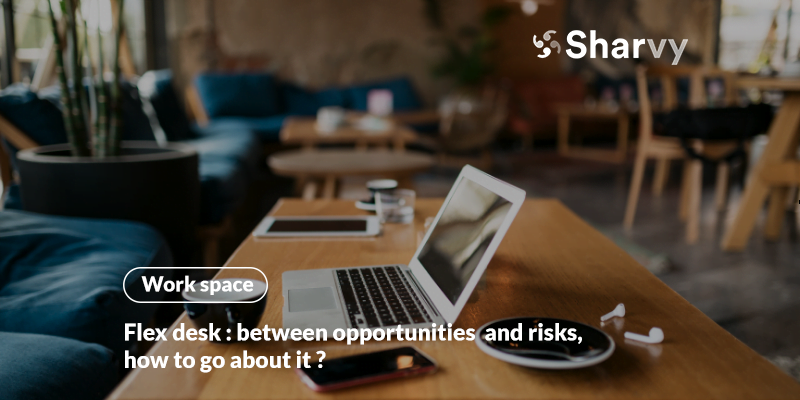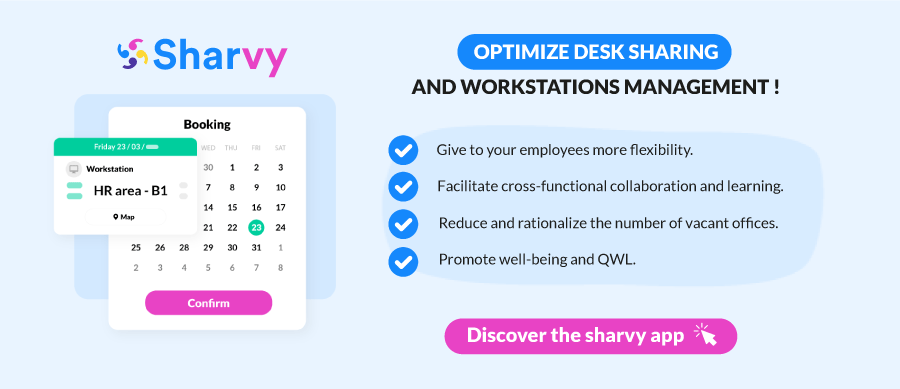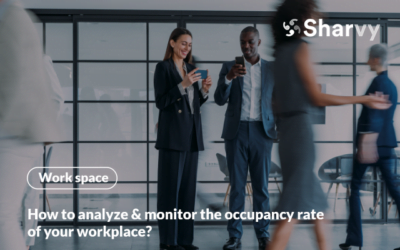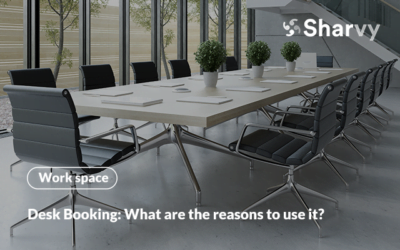In the era of hybrid work, many companies want to take the turn of a new work organization focusing on flexibility, agility, and digital.
This is why they are not hesitating to take the “flex desk” step! An innovative way to avoid financial losses linked to the desertification of their workspaces, following the generalization of teleworking. This is while constantly adapting to the new expectations of employees. A real challenge, right? But far from impossible.
However, transitioning from a “classic” work organization to the flex desk is not without risks and can quickly become a time bomb. To be carried out smoothly, this transition requires a specific commitment from companies to anticipate and respond sustainably to the needs of employees.
So, between opportunities and risks, how do you go about it? The answer in this article.
What is the flex desk and does it apply to all professions? – Let’s find out!
There is no doubt about it : flexibility is undoubtedly one of the most widespread needs among company employees. While this can take different forms : teleworking, flexible working hours, and choice of workspace – open-space, call-boxes, third places, corpoworking – it also concerns the layout and optimization of spaces, hence the flex desk concept.
This consists of no longer allocating a specific workstation to each employee. As a result, employees can choose where they work according to their needs, tasks, and objectives for the day.
Contrary to popular belief, the flex desk is not an epiphenomenon. In other words, and according to a study conducted by the firm JLL, it is not only a matter for startups and/or tech leaders. Instead, the Insurance, Banking, and Industry sectors are among the forerunners!
However, if the flex desk has risen recently, it should not be considered a universal mold. Instead, its success is due to its ability to be adapted to different professions, corporate cultures, and teams. The aim is to formulate a tailor-made response to each organizational story. For example:
It is understandable that employees who go to their workplace every day and occupy several fixed PC screens to carry out their tasks – for example, developers, graphic designers, data analysts, etc. – will not be the best candidates for the flex desk and will be somewhat more reluctant to change. Conversely, employees in project mode and those who work off-site on a large part of their schedules are likely to be more open to this type of practice.
From this observation, it is not aimed at all employees, and it is necessary to define the working methods, professions, and situations conducive to the flex desk within the organization. This is why some companies choose to have all their employees work on a flex desk, and others dedicate only part of their office to this practice.
What needs does the flex desk meet?
The flex desk is a direct consequence of paradigm shifts in the world of work.
On the one hand, it meets an economic need. But, on the other hand, more and more employees are mobile and nomadic and leave their workstations vacant. There are various reasons for this : 5 to 6 weeks of paid leave per year, possible sick leave, maternity/paternity leave, external travel (customers, suppliers), and in addition, 1 to 2 days of teleworking per week.
The reality today is that when you walk around the offices, ¾ of the time, you notice that they are empty! This is the reason to revolutionize and optimize workspaces to reduce real estate costs. But let’s not forget: these unoccupied spaces have a price the flex desk can absorb.
Today, no less than 40% of workstations are unoccupied every day. And yet, the cost of real estate represents the 2nd largest expense item for a company, just after the wage bill…
On the other hand, the flex desk responds to employees’ new uses and expectations. The flex desk and the practice of teleworking go hand in hand. These combined practices offer employees more autonomy, flexibility, cross-functional management, and fundamental collaborative values within an organization. This is a lever for talent retention and brand image. Provided, of course, that the flex desk is deployed correctly.
What are the opportunities & risks of the flex desk?
1. The benefits of the flex desk.
- An innovative way to end vacancy : to take full advantage of this benefit, the idea is to take office sharing literally by pooling workstations. If your company has about twenty employees, you should only offer ten individual workstations. To do this, it is all a question of internal organization and management of the workstations in the form of rotation.
- An efficient method for achieving unstructured teams and impromptu meetings : Every day is a time for new discussions in the flex desk layout. Thus, meeting next to the CEO, the HRD, or whatever becomes possible! It’s a virtuous mix that creates a dynamic working environment. The synergies that are created promote agility, productivity, and creativity. According to a study by JLL, 70% of employees who use the flex desk believe they are more productive, and 56% say that collaboration has improved.
- A practice that offers a wind of freedom in the choice of workspace : in a way, your employees regain power over their work environment. Each day has its desires, objectives, and affinities. The idea is that each space can be used for a specific purpose. This is the whole notion of work flexibility : the rigidity of fixed offices, the same place every day with the same colleagues in sight, is over.
- A practical method of achieving financial & environmental gains : by not having to keep one workstation per employee and by reducing the space required, you improve the profitability of your premises. In this way, it becomes possible to rent smaller but more qualitative premises enriched with services that enhance the QWL. At the same time, the flex desk has its place in your company’s CSR approach. Limiting the surface area rented limits your energy costs (heating, air conditioning, electricity, etc.). At the same time, as the flex desk can be perfectly combined with teleworking, you reduce your employees’ daily commute and, therefore, the carbon emissions associated with your company.
- An accelerator of organizational change : ultimately, and when deployed wisely, the flex desk is a great way to implement and make tangible the change that most leaders want to see in the era of hybrid working. It is an excellent opportunity to rethink current work patterns and to open up to new practices that retain and attract talent.
2. The risks of the flex desk : what are the pitfalls to avoid?
- Imagining that the flex desk is a miracle recipe on its own : obviously, this is not the case and it would be a big mistake to think so. The flex desk depends on the corporate context, the managerial culture, and the new working methods introduced before its deployment. It is a challenge for both employees and managers: managing remote teams, ensuring that everyone is integrated, making the workplace dynamic, etc. Care must be taken not to let employees become isolated and lose their place within the company.
- Not taking into account that the flex desk can cause stress : the implementation of the flex desk can be accompanied by frustration, embarrassment, and loss of time. But also existential questions, such as “Will a workstation be available when I arrive? As a result, nostalgia for the traditional fixed office can quickly set in. This can be explained (in part) by poorly organized flex desks and/or unsuitable spaces. To avoid these pitfalls, think of SaaS solutions such as Sharvy so that your employees can anticipate their needs as well as possible!
- Ignore that office will be more “impersonal” : by its very essence, the flex desk means the end of dedicated spaces within the company. This can generate a feeling of interchangeability or depersonalization among employees, harming their commitment. Therefore, a solid change management strategy is needed to defuse resistance.
- Not supporting this transition internally : the flex desk requires supporting your managers and employees in this paradigm shift. Changing offices every day means adapting to an imbalance they have yet to (really) choose. You, therefore, run the risk of ending up with employees who will have a much more rigid way of working. And thus become incapable of accepting other changes. This is why managers need more guidance and consultation (upstream). It is worth it because, in the long run, people can speak more freely with the flex desk. Everyone lives in the same workspace, without office doors to push.
Flex desk: how to anticipate and organize your transition? 5 tips!
Although the flex desk layout holds great promise, it still needs to be made easier to set up. In addition, it requires the company to reinvent itself as a whole. However, if you feel ready to take the plunge, here are five tips to make your project successful.
1. Ask yourself the right questions and frame your project.
Don’t fall into the trap of saving money at the expense of your employees’ well-being! This is why the first step before changing your work organization is to carry out an internal audit. Observe your employees’ habits and customs to define your project’s precise framework.
Ask yourself : What are their needs? What are their constraints? How do your different divisions/teams interact? What impetus do you want to give your company by switching to a flex desk? What mobility do your employees have within the different divisions/teams? These questions will enable you to approach your transition in the best possible way.
At the same time, ask your managers about the implementation of teleworking within their teams, the obstacles, and the advantages. But also about their vision of the office and its primary use them. Identify trends within the teams.
Also, consider asking your employees about their view of the office. In particular, what they like and don’t like, the ideal location, transport, their working methods, etc. Remember that the earlier your employees are involved, the more they will adhere to the transformation project. This is one of the key factors in the success of your project!
Finally, define the framework of your project. For example, identify a person responsible for the project, define the objectives, draw up plans to understand how the project will be organized, etc. Next, ask yourself whether it makes more sense to reorganize your current offices or to move to an entirely new workspace and build your future organization.
2. Find the balance between flexibility and strict rules
As you will have understood, switching to the flex desk requires real preparation beforehand. This is why providing a minimum framework for balancing face-to-face and remote work is essential for organizing a coherent team rotation.
For example, you can imagine that an employee utterly opposed to teleworking will have a calendar indicating that they go to the office several times a week. On the other hand, an employee who wants to telework three days a week will be assigned two days when they can go to the workplace. It is up to you to find the right balance according to the needs of your teams.
At the same time, keep in mind that it is essential to maintain a ratio of available space per employee. Therefore, calculate the (ideal) desk sharing ratio for your offices. For example, most companies that opt for flex desks set a space ratio of 0.7 – 7 workstations per 10 employees. Below this ratio, it begins to be restrictive for employees and time-consuming for you to organize a relevant rotation between your teams.
3. Multiply the workspaces!
Offer a wide range of spaces to meet the daily needs of your employees.
For example, your sales team will need to spend time on the phone and/or video conferencing without disturbing other employees in the area. At the same time, your HR teams must have quiet spaces available to conduct interviews. Similarly, your finance, marketing & design teams regularly need a double screen, so consider installing several in the areas where they tend to work.
So, redesign your offices accordingly and create a variety of spaces where you can find :
- Individual workstations and open spaces
- Acoustic booths and concentration areas for seclusion
- Informal and collaborative meeting rooms equipped with video conferencing systems
- Informal spaces scattered among the open spaces to break up the rectilinear nature of the offices
- Relaxation and conviviality areas dedicated to the social life of the company, etc.
To help you, download our free checklist!
4. Opt for a desk booking tool!
For a smooth transition to the flex desk, you must offer your employees solutions to reserve a workstation and avoid numerous pitfalls (lack of space, overbooking, discomfort, discontent, etc.).
On this point, the Sharvy solution will meet your expectations! Not only does it allow your employees to anticipate their needs up to 4 weeks in advance by reserving a workstation and/or freeing up an assigned workstation in anticipation of an absence. But the application also allows you to create different zones dedicated to each team.
In this way, it helps your employees to keep their bearings and make a smoother transition. So, each team practices the flex desk within a limited space, which is dedicated to them in an immutable way.
In addition, Sharvy can interface with various tools used in your daily work : HRIS, access control, authentication, etc. This will simplify the everyday life of your employees, as Nelly BARDET, Multimedia Designer in the Talent Development & QWL department at IRD, so aptly explains.
“Sharvy has enabled us to implement the flex office and thus optimize our workspaces. The application is easy to use and ergonomic. With just two clicks, employees reserve a space and a desk as needed or release them when they are not on site.”
Curious to know more about the implementation of desk booking and Sharvy? Check out our case studies.
5. Adapt your hardware, IT & digital equipment.
Remember that to move to the flex desk, you must equip yourself with tools at the cutting edge of technology, bringing you closer to a smart office.
This is why implementing a Digital Workplace is a prerequisite if it still needs to be the case. It combines a set of technologies, platforms, and digital tools for communication and collaboration (instant messaging, document sharing, and management, etc.) and office automation (professional software, emails, diary, etc.) that your employees may need to carry out their tasks.
At the same time, and even more so in the context of the flex desk, giving each of your employees adapters to plug into the various workstations is essential. Similarly, don’t forget to install screens in all collaboration areas with “click and play” technology so your employees can easily share their content and/or presentation.
Finally, please don’t overlook that setting up a flexible organization means accompanying your employees at home, teleworking, and providing optimal comfort. So, in the home and office, offer them ergonomic chairs, a desk adapted to their space, and/or even a new screen for those who want it.
Remember that providing a range of equipment adapted to your corporate culture is to be addressed and will condition the success of your transition.
In conclusion
As you will have understood, implementing the flex desk is not to be taken lightly. While many companies have succeeded in this transformation, others still need help. In the end, implementing the flex desk is a subtle balancing act. Pushing the flex desk approach too far and/or too fast from the start can jeopardize your project.
That’s why it requires good preparation, rigorous organization, and support from professionals like Sharvy, to lead this transformation on the road to success.
Have a question? Check the FAQ!
What are the differences between the flex desk, flex office, desk sharing, and hot desking?
Although these work organizations share the same characteristics, a few differences exist.
Flex-office : is another term for flex desk. This practice means that no employee has a desk in their name.
Desk sharing : assumes that the company has an equal number of employees and offices. Of course, no individual employee is allocated a desk.
Hot desking : also implies that no employee is given a desk in their name. However, the number of workstations available is much lower than the number of employees. Regularly, there is a ratio of 0.7 – 7 workstations for every 10 employees.
How to defuse employee resistance to the flex desk?
There is no doubt that transitioning from a “classic” work organization to a flex desk organization can be difficult for your employees, with a relatively strong resistance to change. Because when you say flex desk, you mean the loss of your “personal space,” which can be experienced as an outcast from the company.
Of course, it can take time for employees to accept the change. However, the persistent resistance of some people should maintain the whole project! To limit this resistance, involve your employees as much as possible in your transition and from the beginning of your reflection. This participation on the part of your employees will encourage them to take ownership of the new flex desk working environment, to become attached to it, and to feel in control, which are sources of satisfaction.
What are the main challenges of transitioning to flex desks, and how can they be overcome?
Transitioning to flex desks can present challenges, notably the loss of familiar landmarks with the disappearance of individual desks and the adaptation to new collaborative spaces. To overcome these obstacles, it is important to properly prepare for the digital transformation, support employees with appropriate training, and ensure a work environment that promotes both well-being and flexibility. Transparent communication and involving teams from the start of the project are also essential for a successful transition.
Want to learn more? Check out our latest articles!
How to analyze & monitor the occupancy rate of your workplace?
How do you calculate the occupancy rate of your workplace? What is the difference with the expansion rate of your offices? Focus!
Desk Booking : what are the reasons to use it?
What is desk booking? Who is it for? What are the advantages and disadvantages of this practice? Find the answers here.
Hospitality management : the right business strategy?
What is Hospitality Management? Is it the right business strategy? What are the benefits? Focus in this article.
Subscribe to our newsletter!
Resources
Contact us
+44 117 463 6990







